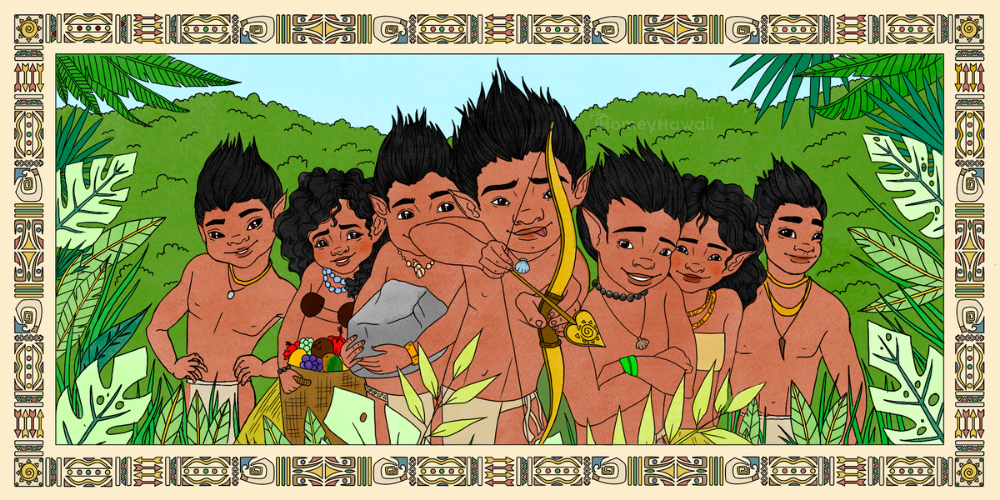
Menehune, Hawaiian Leprechauns
Lose your keys, it’s the Menehune. Can’t find your purse? The Menehune stole it.
If you can’t find something, they took it. Stealing little things is part of their rascally nature. When you eventually find what you lost, it’s them giving it back to you.
So who are these Menehune? Picture elves dressed in Hawaiian Ti-leaves between 6 inches and 2 feet tall, very smart, strong and skilled in building things with rocks. That’s the ancient, mythical Hawaiian dwarf called a Menehune [Me-ne-‘hu-ne]. If you can believe in magical tiny people you’re ready for this story.
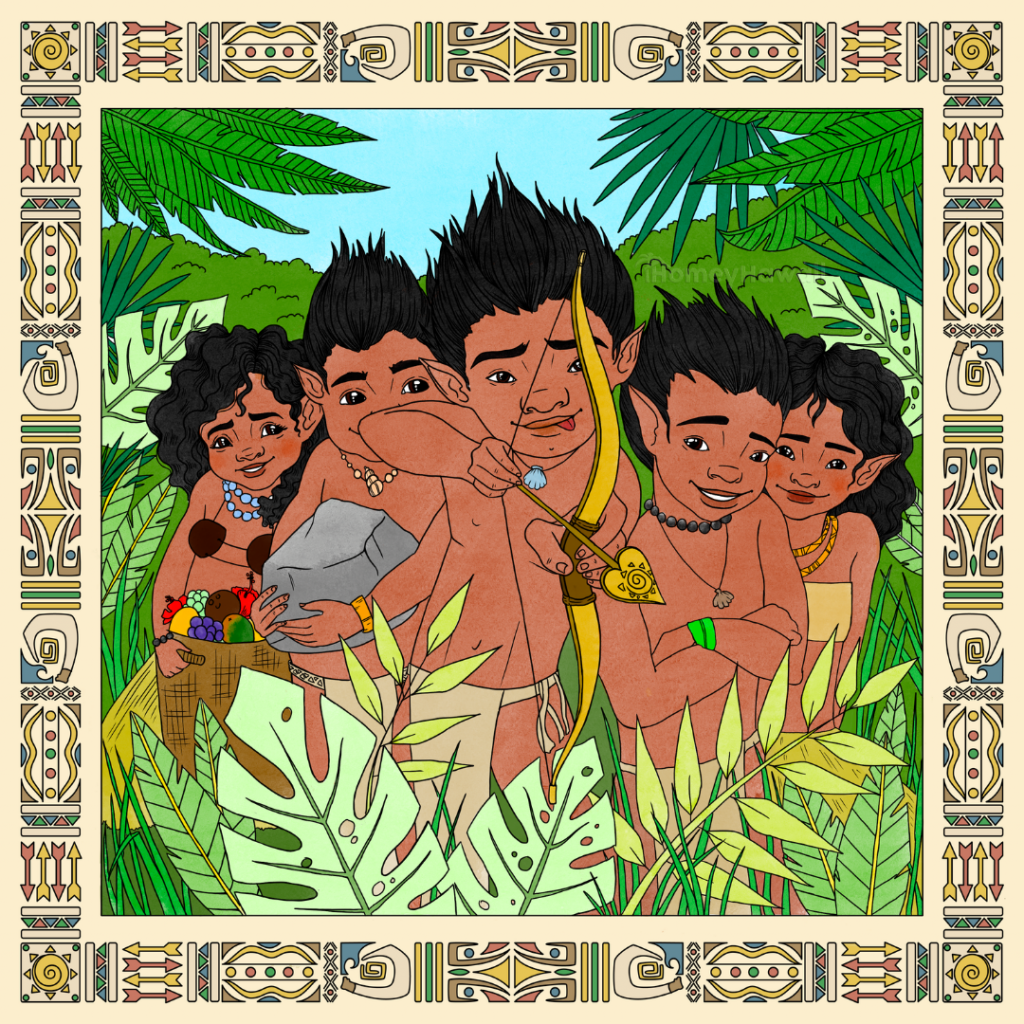
Many legends grow larger with time, but these little guys got smaller. Like all legends, this one begins in reality. History tells us that over a 1000 years ago, when Tahitians (later called Hawaiians) arrived in Hawaii, they found a race of people there. Thinking that they were big stuff compared to others, the Tahitians saw them as lowly ‘commoners’. In their language lowly ones were called “Manahune”. The ‘a’ in the word eventually turned into an ‘e’ and that was their name forevermore. These native inhabitants were probably regular in size, but after being put down and belittled for so long, people started to believe that they were actually small. They shrunk with time.
They seem to live mostly on the island of Kauai. Given the fact that Hawaiians, and people in general, believe in mystical things, according to the 1820 census of Kauai, 65 people were actually listed as being Menehune! That’s what you call believing in fantasy! They say that up to 90% of people living in Iceland believe in elves and fairies, so it’s fair to say they would definitely believe in the Menehune.
An interesting group these Menehune. They love to dance and sing and dive into the ocean from high cliffs.
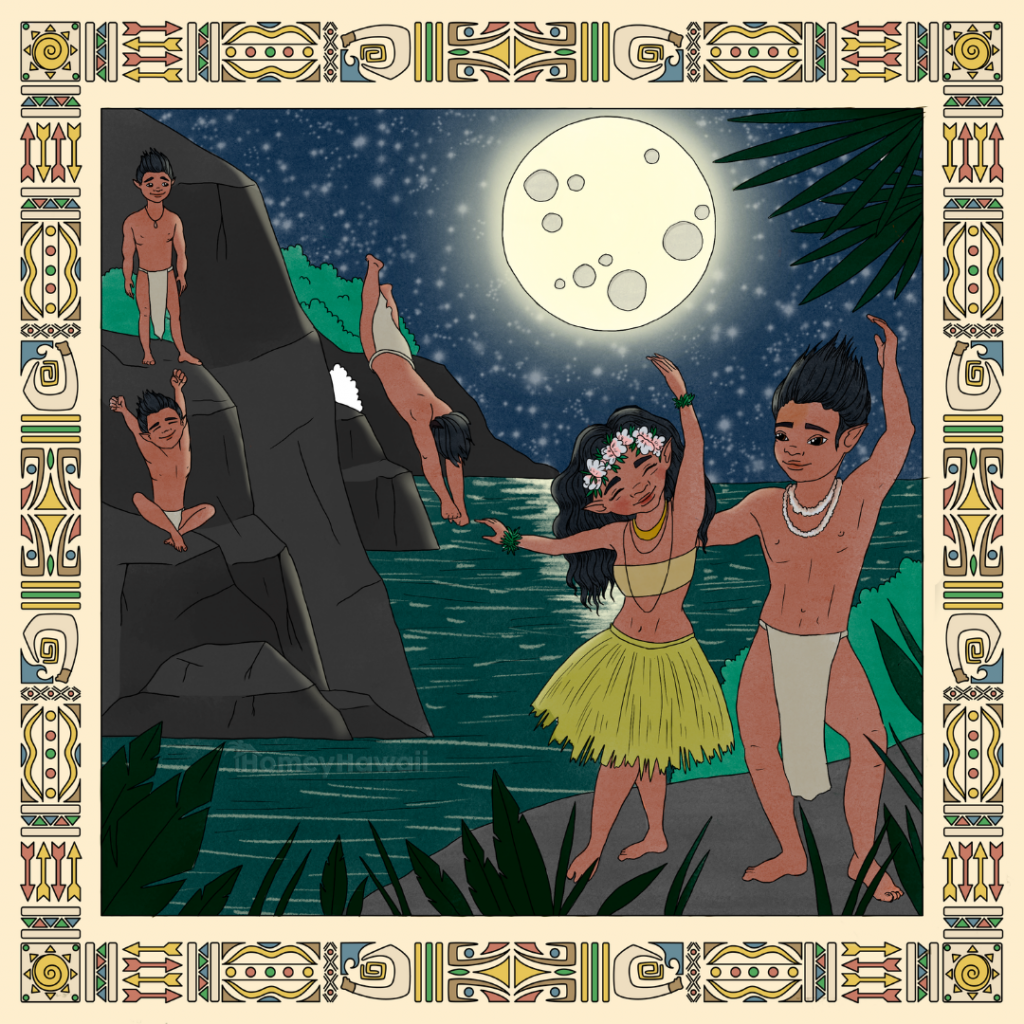
The Menehune are shy and only come out at night. This is a traditional trait of some mythical characters, but there might be a good reason they run and hide at night. Originally, the newly-arrived Polynesians looked down on them and probably treated them badly, so it makes sense they hid from them at night. Today they still do so, but maybe it’s just part of their magic.
Maybe they really are six inches tall and have secret powers. Maybe they actually exist, who’s to say? Do Santa’s elves exist? You just never know. But the real interesting thing is they shoot arrows like Cupid. They shoot an arrow with a magical bow making people have feelings of love. Cupid wearing ti leaves… Now there’s a sight!

Besides singing and dancing, mostly they work, and always at night. Hawaiian legends tell how they built temples, fishponds, roads, canoes and houses always in darkness. If anyone saw them they would instantly stop working and disappear.
Like real people and fictional characters, they have their big claim to fame, the one thing they’re known for. With the Hawaiian elves it’s building a gigantic fishpond overnight called the Menehune Fishpond, in Hawaiian the Alekoko [a-le-‘ko-ko] Fishpond. The Menehune lined up in a row for 25 miles and passed stones hand-to-hand to build the pond. It’s a real pond in Kauai, actually built 1,000 years ago, supposedly by the little people. Legends surround it.
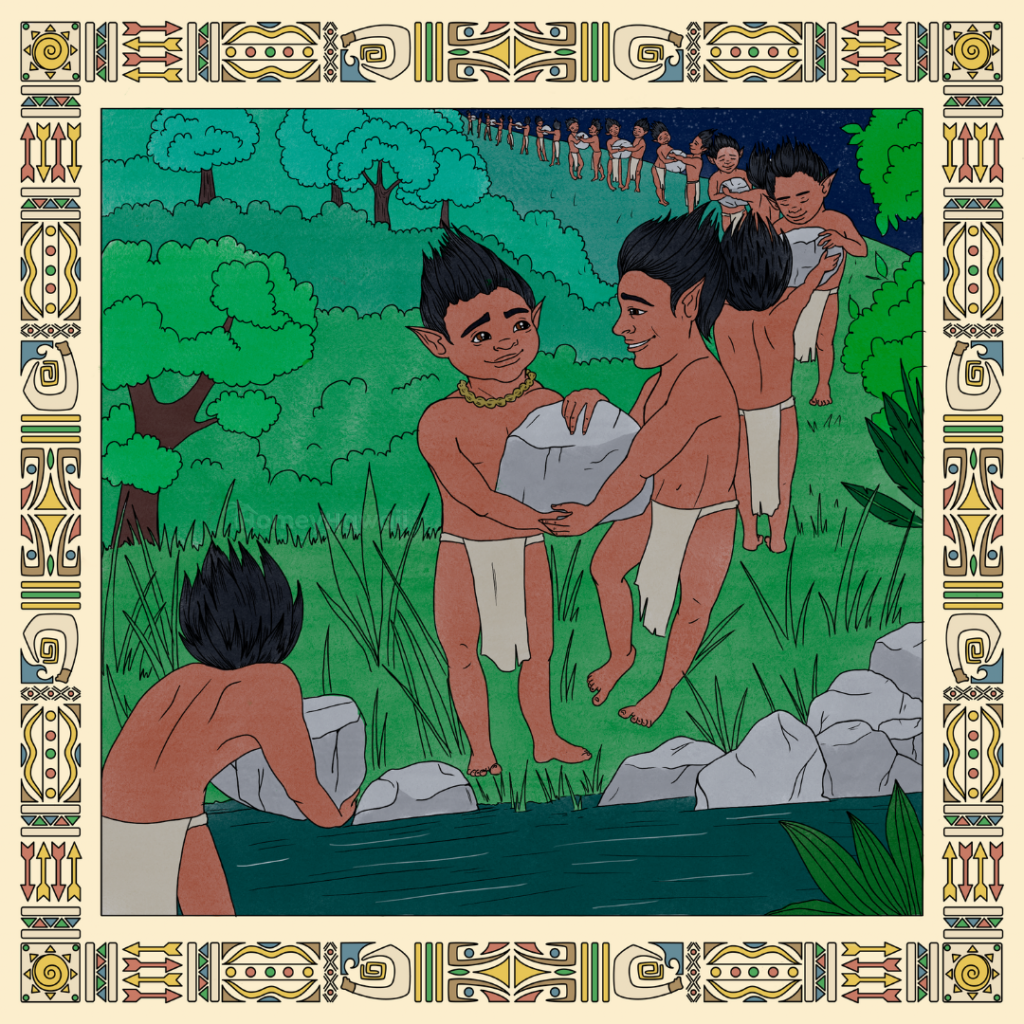
It is said the Menehune built the Alekoko Pond for a princess and her brother. They worked at night because that was their nature. If anyone saw them – poof! – the elves were gone. They really didn’t like to be seen but it could also be bad luck for anyone who spied them. And that’s exactly what happened the night they were building the fishpond.
The princess and her brother could not resist sneaking out to watch the dwarfs at work. Bad idea. As dawn was breaking, the Hawaiian elves were getting off work and discovered the two nosey ones watching them. Sorry to say the Menehune turned the princess and her brother into pillars of stone. Too bad, and you guessed right, the two stone pillars can be seen near the fishpond today.
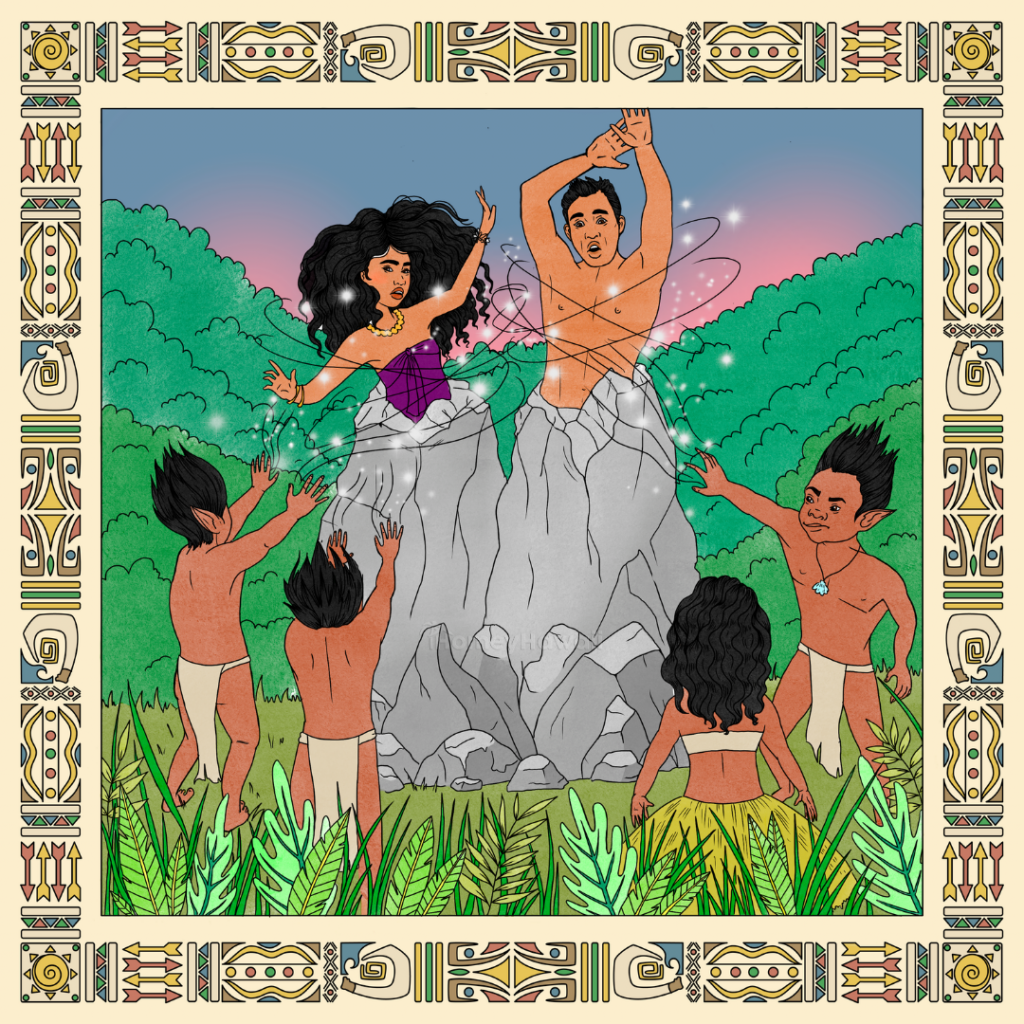
The Kauai elves had cousins on other islands, namely the island of Maui. And here is another charming tale. It seems that in the Ainahou [A-i-na-‘ho-u] Forest just north of the Haleakala [Ha-le-a-ka-‘la] Crater there lived 3 magical Menehune – Ha’alulu [Ha-a-‘lu-lu], Molawa [Mo-‘la-va] and Eleu [E-‘le-u]. They each had special powers, mainly to disappear.
Ha’alulu means “to tremble”; this little man was always cold and whenever he’d start shaking he would turn invisible and walk around unseen. Molawa means “lazy” and whenever he looked like he was sleeping, his magical self would be invisible and go around doing good deeds. And lastly, Eleu, his name means “quick and nimble”. Unlike his lazy friend, Eleu was so quick he’d disappear. They could be anywhere, even right next to you.

There they are, sensitive Cupids who like to dance and sing, and at the same time strong workers who build fishponds and temples. They are people of the night and don’t like to be disturbed while working. They punish anyone who intrudes but at the same time are known for doing good deeds. All over Hawaii the local people believe that when you lose something the Menehune stole it, but they usually give things back.
They sleep during the day and come out at night so chances are you’ll never see a Menehune, except in the magical place in your mind. There’s one, can you see him? A foot-tall Hawaiian dwarf, wearing ti-leaves, smiling and saying aloha [a-‘lo-ha]!
Illustrations by Mariia Kudrina.
A Brief Guide to Hawaiian Pronunciation Transcription
Words in square brackets [ ] show the pronunciation of Hawaiian sounds and words. The words are broken in syllables by dashes, and there is an apostrophe in front of the stressed syllable. Disclaimer: our transcription is simplified and doesn’t cover all aspects of Hawaiian pronunciation.
Example: aloha [a-‘lo-ha].
[a] makes a short “ah” sound like in the word “but”
[e] makes a short “eh” sound like in the word “let”
[i] makes an “ee” sound, but short like in the word “tip”
[o] makes a short “oh” sound like in the word “top”
[u] makes an “oo” sound, but short like in the word “put”
All vowels can be short or long. To indicate a long sound, a horizontal line (macron) is placed over the vowel. It is called kahakō in Hawaiian. The syllable with the long vowel sound is often stressed. In our transcription, the long vowels are indicated by placing a colon after the vowel – [a:], [e:], [i:], [o:], [u:].
Example: Haleakalā [ha-le-a-ka-‘la:]. Last [a:] sound is long and stressed.
A glottal stop (‘okina in Hawaiian) means a complete stop before a vowel, in front of which it is placed; similar to the stop in between the syllables of “oh-oh”. We don’t show the ‘okina in our transcription, because we reserve the apostrophe to indicated the stressed syllable and because the ‘okina is clearly visible in the word itself.
Example: Hawai’i [ha-‘vai-i].

Dennis Gregory is a long-time writer, he lives in Kona, Hawaii. In 1970 he founded the first literary magazine at the University of Hawaii, Hilo. Since then he has published novels, poetry books and writes a column for the local paper in Kona. He is also an artist and musician.







